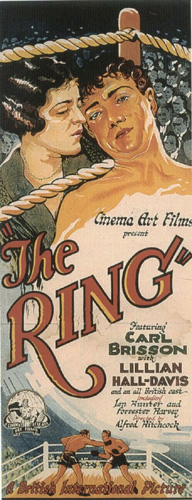written and directed by Alfred Hitchcock
I got an iPod that can play videos! Now I can watch movies while I’m on the subway!
For my first commute movie I watched The Ring, the first selection in that DVD set of early Hitchcock movies I picked up at Barnes & Noble for Beth on a whim a few months ago. We haven’t watched a one of them yet.
But now I have! ON THE SUBWAY!

My headphones are great and all, but a silent is a good choice for the subway. This version has an improvised-sounding piano score a la the good old days, which is (so far as I can tell) totally uncredited on this DVD set. Following these particular transfers back through their “StudioCanal” logos, however, I presume that this is the soundtrack from the 2005 French DVD release, which was credited to one Xavier Berthelot. He seems to be playing on a synthesized piano rather than a real one, and frequently when he Mickey-Mouses the action it becomes clear that the sync is off by a second or two. That’s no good. For the most part, the score meanders as though the pianist hasn’t seen the movie yet, and focuses on the superficial at the expense of the underlying significance. That may well be historically accurate, at least for a lesser movie house in 1927, but the style of the music itself wasn’t, and once real authenticity went out the window, the music might as well have been better and smarter. Several times I wanted to turn it off so I could get a better sense of what was really going on, but that wouldn’t have been satisfying either.
The movie is a very rudimentary melodrama – two boxers fight for one girl, known as “The Girl” – but the filmmaking holds up very well. The technique seems ahead of its time; particularly so, in fact, when contrasted with the dated substance of the story. The performances are quite relaxed and tasteful compared to the wide-eyed knuckle-biting that one might expect from a movie like this, and it’s very well shot. Hitchcock pulls all sorts of clever artsy tricks out of his sleeve that stylistically fall somewhere in between Murnau’s Sunrise (from the same year) and the trademark Hitchcock visual style of the later movies. Several scenes ended with sardonic visual “winks” that I think I would have been able to recognize as Hitchcock without any help.
But the movie is far more memorable as a string of cinematic ideas than as any kind of emotional experience. Because of the care and attention to detail, at first you might think that it’s a nuanced elaboration on the typical melodramatic love triangle, but the nuances don’t tally up properly and it all ends as patly as any other forgettable formula flick. Hitchcock the writer doesn’t fare as well as Hitchcock the director, but I get the impression that the writer was mostly interested in setting the director up with things he wanted to shoot visually.
I particularly liked a shot of a boxing match, framed as though the viewer has just entered at the back of a large audience and is not quite able to see the boxers over the silhouetted heads of the crowd. Also a startling effect when the camera takes the POV of a drunk and the image smears as the camera begins to tilt queasily downward. The whole movie builds up to – surprise! – a boxing match, and the finale is a very laudable attempt to make a high-tension scene of action. It’s not nearly as polished as the action sequences that Hitchcock would later achieve (and which would go on to engender a whole realm of filmmaking in themselves) but it’s smart and looks good. When the camera pushes in on each of the boxers in turn as they approach each other, it feels like we’re seeing the future of movies. TCM could totally put that shot in a promo.
Anyway. Naomi Watts was pretty good as “The Girl” in the American remake but the rest of the story got a little muddled. Jack Black was miscast in my opinion. And when Doris Day screams it’s not as scary as in the Japanese version.
But that’s Hollywood for ya!
Cool! What kind of iPod did you get? And, um, I think I followed the train of thought in the last paragraph, except…Doris Day. But now I see “The Man Who Knew Too Much” had an earlier incarnation, in 1934. Now that I roll it around in my mouth, though, isn’t that a very lumpy title for a movie about a man who may or may not know too much?
And screaming is important in both movies.